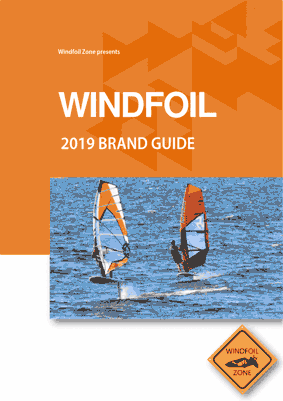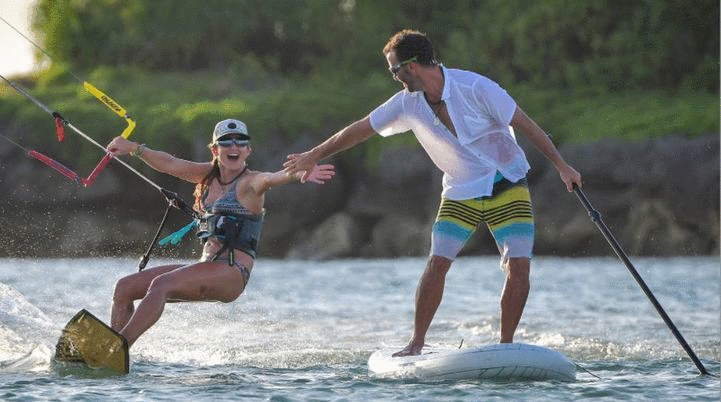A Short Summary of the 2018 Foiling Year and What We Can Expect in 2019
- Romain
- Dec 22, 2018
- 7 min read
2018 is coming to an end, time to make a summary of this amazing foiling year.
What happened in 2018?
Equipment - windfoils
In terms of foiling equipment, we can only note that many new brands have entered the market, offering a large assortment of windfoil equipment to the public. While 2017 had a clear orientation towards race foiling, with expensive and elitist products, 2018 gave a much wider offer of products with stronger freeride/freerace direction.
Manufacturers seem to have understood that we should avoid what nearly killed windsurfing in the ’90s, namely a too complicated and expensive product offer, only answering the needs of a very small portion of the population.
(Pic: James Jagger)
Windfoiling really became interesting for many this year when new products were launched at a reasonable price, with a good balance between performance, fun & easy to learn and plug & play systems.
People have also realized that you don’t need a €2000 carbon foil to do just that. Many brands have now launched aluminium or aluminium hybrid foils which offer great quality products at a relatively low price. To name some: Neilpryde aluminium and Glide, starboard GT, Zeeko, Horue, Mantafoils, Slingshot, and Naish.
At the same time, carbon race foils are remaining the best foils for speed and flying upwind, but a bunch of new “freerace” foils offer a good compromise between speed, upwind performance, and freeride fun. Plus, that's at a very reasonable price. Good examples are Alpinefoil, Bug foil, RRD, Starboard or AFS.
Equipment – foil boards
When it comes to windfoil boards, it looks like the standard freeride windfoil board is about 130 L, less than 250 cm, and about 80 cm large. But we see brands experimenting and trying new concepts. Horue and Slingshot for example have launched tiny boards with a clear freestyle/manoeuvre orientation.
Race boards on the contrary, have been focusing on the width of the board, to give more leverage over the foil. Some boards can be up to 100 cm large and actually look more like a door then the surfboard! Fortunately, the PWA (Professional Windsurfers Association) has given some new guidelines and limited the maximum width to 91 cm during competitions.

Starboard Foil 177 - windfoil board
Equipment – windfoil sails
Windfoil sails are the last category to have seen innovations to improve foiling sensations. At first, many thought that brands were using this “foiling trend” to make all product “foil ready”, as the need for dedicated sails for windfoiling was not obvious. However, after testing it you soon realize that you can windfoil with any kind of sail, but windfoil dedicated sails offer great features which make foiling easier and more comfortable.
Windfoil sails have indeed some common features to give you optimal sensations in flight: early power to get on the foil, less sensitive to gusts and more stable, light in the hands.
My favourite sails are the Loftsails skyscape and the Ezzy hydra, but several other brands have launched their own model and more are coming for sure.
You can find the whole list of windfoil sail producers in our windfoil brand guide.
What trends should we expect in 2019 and onward?
In terms of equipment, we can already see that there are a lot of innovations coming out. Some new brands are entering the market, other are expanding their range. There will be so many products available on the market that it may become complicated to make a choice.
Fortunately, Windfoil Zone is here to guide you, and we will make sure to have our brand guide (and the 2019 version of our windfoil e-book) updated at all times (new version of the e-book to be released in January 2019).
For the hydrofoils, the trend is to push the limits in all directions:
• Stiffer carbon (UHM carbon) for race foiling (Read about carbon fiber used in foils here)
• Longer mast (up to 105 cm) to get better control of the height and go through the chop easily
• Longer fuselage (up to 110 cm) to gain in control, upwind performance, and stability
• Stronger fuselage with titanium will probably be coming soon
• Larger front wings (both area and wingspan) to get an early lift
Large Slingshot's FWIND Front wing
One real innovation though is the new load plates on which enables the rider to use boards with a powerbox fin box. Deep Tuttle used to be the standard for windfoiling, but it also demanded a new board with a reinforced Deep Tuttle fin box.
With these new load plates, the load from the mast is spread over a larger area at the bottom of the board, and it reduces (but doesn’t eliminate) the risk of damaging the board. We have seen this system on Mantafoils so far, but Neilpryde and Zeeko are now launching foils with load plates and powerbox box in their 2019 collection.
Being able to use powerbox boards will probably help to convince people to try windfoiling, as they will not have to buy a dedicated foil board anymore.
Video explaining how to assemble the new Neilpryde's load plate
Boards:
I also believe that several board producers will develop windsurf boards, which are “foil ready”, i.e. that have a deep Tuttle fin box and can be used both with a foil and a regular fin.
Goya is for example still focusing on hybrid windsurf boards, which are both excellent for windfoiling and windsurfing. Starboard Isonic is also a great alternative, and Bic is also about to launch a convertible windsurf/windfoil board 2019.
New BIC Techno windfoil convertible
Personally, I'm surprised that there aren’t that many brands doing the same. Few people are interested in having multiple boards in their garage. A “one size fits all” board is just
perfect for the average guy windsurfing on weekends and using the same board for all conditions: foiling with wind under 20 knots, and regular windsurfing when the wind is stronger.
When it comes to sails, I think we will continue to see some innovations as well to improve the foiling sensations. We have already seen some interesting shape concepts with the Ezzy Hydra and the recent Gun Sails Bow, and we will probably see some more soon, for example from Gaastra.
What have we learned about windfoiling so far and what has changed since 2017?
The big change in 2018 has actually been how people have embraced windfoiling. At first, windfoiling was seen as an alternative to formula windsurfing. The main discussion on social media and forums was about “how low wind you can go”. 8knots, 6 knots, 4 knots?
While foiling in 6 knots is possible, it’s not something everybody will manage or even enjoy. To do so, you will need the best performing foil, large sails, and be an experienced foiler. I believe that the majority of people will prefer foiling in 10-12 knots of wind, with a normal sail size (6.0 - 7.0m or less).
Foiling in 12 knots is really fun and a thousand times better than slogging around with a large sail on a regular windsurf board. A direct outcome is that you multiply your number of sessions instead of sitting on the beach waiting for the wind to pick up. It’s a bit like in the good old days with the “windsurfer”, having fun out on the water - no matter how crappy the conditions were!

Marcello Morrone of Katanka Windsurf ing Club taking a foiling jibe
Different foil-styles
2018 also saw the emergence of new styles of foiling. Foiling is no longer only about big boards and big sails in light wind. We have seen a tremendous evolution in Freestyle foiling, or foil-styling with the Müller brothers and Wyatt Miller of Slingshot pushing the limits of what is possible on a foil.
Wave-foiling is also getting more popular , using the sail to pass the swell and surfing back on the waves without any pressure in the sail. This is the birth of term WWF (wave windfoiling) as Casey Treichler likes to call it (read his blog reef warriors)
Where is windfoiling going?
The big question remains: will windfoiling become something “everybody” does in the future, or will it remain a niche in the windsurfing sport which only attracts a small portion of the windsurfing community?
Everybody who has tried windfoiling agrees that it’s fun, addictive, and it transforms what we call no-wind days into a fun day on the water. The main drawback of windfoiling for the moment is, of course, the price of the equipment. The entry-level price to get started with new gear is €2000 minimum for foil and board, and can go up to €3000 or €4000, unfortunately. (read our article "which windfoil shold I buy?")
However, this will hopefully change in 2019 and onwards, as there are more and more brands fighting for attention in the market. This may result in price competition and eventually lower prices for the consumers.
The second-hand market should also start to be interesting to look at. Foils will start to be for sale in Facebook groups and local windsurf markets, which should allow many people to buy their first kit at a more affordable price.
I also expect that most windsurfing clubs will get into windfoiling and will offer courses to learn how to foil and opportunities to rent foils. This is a great way to try foil windsurfing the first time, and see if it’s something you will enjoy before you start investing in your foiling kit.
A final word
My personal view is that we are just at the beginning, equipment is evolving fast, more and more people get hooked every day, prices may decrease a bit.
I believe there will be more and more hybrid boards which can be used as a windfoil board in light wind, and as a regular windsurf board in stronger winds.
The foil will become a normal piece of equipment everybody needs in their quiver.
I’m looking forward to the new year and have lots of expectations:
- More innovation from brands
- New insane moves from Balz and Jacob Müller
- New hardcore races on the PWA
- More wave foiling
- and more people on all windsurfing spots with a foil.
Happy new foiling year!













Comments